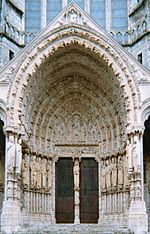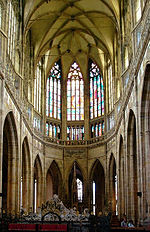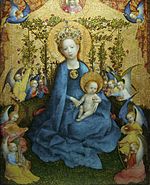Aesthetics
![]()
Aisthesis is a redirect to this article. For the publisher see Aisthesis Verlag.
Aesthetics (from ancient Greek αἴσθησις aísthēsis "perception", "sensation") was, until the 19th century, primarily the study of beauty, of regularities and harmony in nature and art.
Aesthetics literally means: the study of perception or sensual viewing. Aesthetics is therefore everything that moves our senses when we look at it: Beautiful, ugly, pleasant and unpleasant. A doctrine that deals only with beautiful things is called callistics.
In everyday language, the term aesthetic is now often used as a synonym for beautiful, tasteful or appealing. In science, the term refers in a narrower sense to the qualities that influence how people evaluate something from the point of view of beauty. In a broader sense, aesthetic refers to the qualities that influence how something affects us.
In philosophy, the word is often used differently. There, aesthetics refers either to the theory of sensory perception in general (not only of art) or to a philosophical (or sociological) theory of art or design. According to some views (especially those following Immanuel Kant), aesthetic evaluations are not simply decided by purely subjective categories such as "beautiful" and "ugly", which are attached to the object because of certain characteristics. Rather, it is the manner of sensuousness or meaningfulness that is decisive. Other (semiotic) aesthetic theories emphasize that the latter in particular can only be understood within the framework of specific sign systems. Particularly in empirical studies (such as experimental aesthetics), but also in some philosophical theories, one speaks, as in everyday language, of aesthetics as a science or theory of beauty (and thus also ugliness) that investigates how aesthetic judgments come about. In the Anglo-Saxon world, aesthetics is sometimes understood more strongly in this sense. Some, especially recent, approaches also attempt to combine both aspects.
Aesthetics as a philosophical discipline
→ Main article: Philosophical aesthetics
The term aesthetics (Greek for "sensual perception") was first used in the 18th century by Alexander Gottlieb Baumgarten in the context of a philosophical treatise. Baumgarten is therefore often regarded as the founder of "philosophical aesthetics", although philosophers such as Aristotle already dealt with the subject in antiquity.
Aesthetics is not a closed philosophical discipline, as there are different understandings of which subject areas it includes. Often, aesthetic is used as a synonym for beautiful, tasteful or appealing. However, aesthetics also includes other value judgments and aesthetic predicates, such as sensual, fascinating, ugly, or boring. A particularly important role for philosophical aesthetics is its definitions. Until the 19th century, there were three main definitions:
- Aesthetics as a theory of the beautiful
- Aesthetics as a theory of art
- Aesthetics as a theory of sensual cognition
Since the 19th century, however, these theories have been called inadequate because they either do not include all areas of aesthetics or even describe facts that go beyond aesthetics. For this reason, an alternative definition of aesthetics emerged.
Furthermore, different methods are important to define and understand aesthetics. For example, a conceptual analysis is carried out first, and then lexical or stipulative definitions or explications are filed. Furthermore, one's own intuitions can help to identify the deeper meaning of aesthetics, as these can be used as a "red thread" to understand aesthetics.
Middle Ages
Medieval aesthetics counted painting and sculpture as well as the crafts among the artes mechanicae, which serve everyday life. Therefore, the visual arts are treated within the framework of technology (so already in Etymologiae of Isidore of Seville; † 636). Art was thus regarded as the skill of working a matter and fulfilling a purpose. This purpose usually consisted in metaphorically symbolizing an absolute reality in such a way that a strong emotion was triggered in the viewer, which could change his life.
Theoretically beyond the technical encyclopedia of Isidore leads the Schedula diversarium artium. In the topographical and literary description of works of art, interest in the beautiful form prevailed under the influence of antiquity and especially in Byzantium.
The Second Council of Nicaea confirmed in 787 in connection with the question of images that painters only exercise the ars, i.e. the craft, while ingenium and traditio, i.e. the creative part, are contributed to the work of art by the ecclesiastical patrons. This conception of the relationship between artist and patron remained of fundamental importance throughout the Middle Ages. Architecture occupies a special position, being closer to the scientific disciplines of the seven liberal arts, although it serves a practical purpose.
The foundations of medieval aesthetics, which remained valid until the 14th century, were laid by early Christian thinkers such as Origen (185-254), Augustine (354-430) and Pseudo-Dionysius Areopagita (late 5th to early 6th century) in the Christian confrontation with late antique Neoplatonism. On the one hand, they conceived of everything sensual as apostasy from God; on the other, they asserted an analogy between transcendent and material being, between divine and earthly beauty. From this resulted the most important principles:
- The earthly visible things are "dissimilarly similar" images of the invisible divine truths (Pseudo-Dionysius: imago dissimilis): Pseudo-Dionysius explained by the example of the sunbeam, how an ever denser matter impairs the emanation of the divine light, until this can only appear obscured, in riddles. The sensuous "image" is given less importance than the supersensuous "archetype," which in it is symbolically represented. The order of precedence also played a role in the relationship between ecclesiastical cult and art. For a long time, the Eucharist, relics, cult space and equipment were accorded a higher degree of being, knowledge and beauty than visual art, whose cultic function was disputed in the early Middle Ages on the basis of the Old Testament ban on images. Basil the Great (330-379) and John Chrysostom (344/349-407) valued images as room decoration, as a means of remembering biblical history, and as instruction for the uneducated.
- Allegorical conception of beauty as an analogy of the supreme beauty of God: beauty is an objective quality of being, the artist (artifex) does not create it, he only has to emphasize it.
- The beautiful is equated with the categories of the true and the good. Since beauty is defined as perfection, even the least things possess beauty, even matter itself, even evil and ugliness, for they have their place in the hierarchically ordered totality of creation.
- The "anagogic" conception of art. Abbot Suger of St. Denis (1081-1151): "The weak spirit rises to truth through the material". By contemplating (contemplatio) the works of art, in which the artifex has brought to bear the objective existing beauty, the human spirit can be led to the comprehension of the supersensible world. Ultimately, in this view, sensual perception is accorded a higher value than rational cognition. Richard of St. Victor († 1173) places contemplatio as the highest form of cognition above cogitatio (thinking) and meditatio (reasoning). Therefore, art, although counted as a craft, is even superior to the sciences, since it makes the universally intelligible visible to man, which remains inaccessible to his intellect.
- The didactic conception of the work of art. In addition to the function of making the invisible visible, the instructional purpose of art directed towards earthly life played a major role, its conception as "memoria rerum gestarum" (memory of events), formulated at the end of the 6th century by Gregory the Great and in 791 by the Libri Carolini (II, 10). It justifies and demands nature-imitating and narrative representations in order to explain to the public the order of the world, the place of all things and of men in it, and the desirable modes of conduct. According to Bernard of Clairvaux (1090-1153), art should "hold up light to the mind, form to morals, punishment to sins, piety to feelings, discipline to the senses."
- The main component of the beautiful throughout the Middle Ages is the beauty of material light as an image of spiritual light. The Neoplatonic metaphysics of light was especially determined for the European Middle Ages by Johannes Scotus Eriugena (ca. 810 to after 877) in his translation and interpretation of the Pseudo-Dionysius. Beauty as luminosity united the objective beauty of matter (insofar as it is shiny, translucent, reflective) and the technical treatment of matter by the artist, who had to make it as luminous as possible. The appreciation of gold, radiant colors, of gemstones and materials such as alabaster and rock crystal, especially the colored glazing of Gothic sacred buildings is related to the metaphorical conception of light.
In the course of the development from patristics to scholasticism and beyond, the theories differentiated as part of the theological controversies, especially between philosophical nominalism and realism. In the conception of the beauty of art, on the one hand the rational, on the other hand the emotional-mystical accents increased, and the consciousness of aesthetic independence grew (already the Schedula diversarum artium (Roger von Helmarshausen), around 1060/90, goes beyond a technical encyclopaedia in its theoretical approach). The most important criteria of beauty became light and colours, the variety of parts in the whole, which also includes the attentive observation and reproduction of natural reality. Already Bernard of Clairvaux had set against the Dionysian-Augustinian imago dissimilis with the concepts of rationalis species and spiritualis effigies an ideal of beauty of tranquillity and simplicity, which corresponded to the theological concept of the mysticism of love (see mysticism) instead of the previous idea of the punishing judge-god and made use above all of the metaphysics of light (union of the enlightened soul with the highest light). Proportions based on mathematical ratios, on the other hand, played no role in the Middle Ages and only reappeared in the transition from the Late Middle Ages to the Renaissance in the course of the rediscovery of ancient architectural aesthetics.
Light and colours are central to Hugh of St. Victor (1096-1141), who emphasised the variety and diversity of perceptible beauty in contrast to the supreme divine beauty (multiplicatio et variatio universorum), which also corresponded to the scientific findings of the cathedral school of Chartres.
In Thomas Aquinas (1224/1225-1274) we find a classical ideal of beauty (influenced by Aristotle) of clarity, balance and order. Claritas, perfectio, proportio are his criteria for the beautiful, which evokes in man the satisfaction of perceptive knowledge, and this on the basis of the consciously designed form, which must be clear and determined. The separation of the categories good and beautiful, the evaluation of the beauty of matter in terms of its purpose are the essential innovations compared to the traditional understanding.
Alongside the Dominican rationalism of Thomas Aquinas, Bonaventure (1221-74) represented a conception of beauty as light, which, in accordance with Franciscan emotionality, is understood as leading the soul to God, i.e. in the anagogical sense. Common to both, however, is the theory of images that are true to reality, which in a classically disciplined form have to bring things and events close to the senses of the viewer by being as close to nature as possible. This activates the old principle of memoria rerum gestarum and at the same time builds a bridge to the accomplished "visualization" of the Renaissance.

Portal of the Cathedral Notre-Dame de Chartres

Light-flooded room: Choir of the Prague Cathedral

"Madonna in the Rosenhag", c. 1448, mixed media on wood, Cologne, Wallraf-Richartz-Museum
Search within the encyclopedia